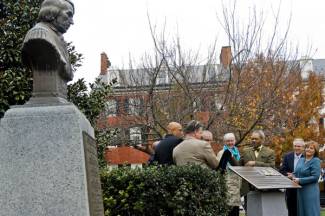Collection Name
About
Balancing history — Dred and Harriet Scott plaque dedicated at City Hall
More than 150 years after the U.S. Supreme Court issued the notorious Dred Scott decision affirming slavery, Frederick marked the dedication Tuesday of a plaque to Dred and Harriet Scott in front of City Hall.
The plaque, which stands a few steps from the bust of Roger Brooke Taney, is the culmination of more than 2 1/2 years of painstaking deliberation and debate. It is a compromise between residents who wanted the Taney statue gone and those who consider him a great jurist whose racial views reflected the tenor of his times.
Some groups had called for the Taney bust to be removed, including the Frederick County branch of the NAACP. Others believed it should stay on the grounds of City Hall, where it was erected in 1931.
Local NAACP President Guy Djoken said the plaque turned out to be a better solution. By seeing both Taney's face and his words, "children will now have the opportunity to know why this was a problem," Djoken said.
Taney, a Frederick lawyer and chief justice of the United States, is responsible for the Supreme Court's notorious 1857 decision that ruled black people, whether freed or slaves, were not considered U.S. citizens. The 7-2 decision also declared that Congress had no authority to prohibit slavery in any of the country's new territories.
Robert Bell, chief judge of the Maryland Court of Appeals, said the Dred Scott opinion was "the ultimate bad decision," written by a justice who "relied on poor scholarship and weak reasoning."
The ruling, Bell said, "left America in shock and throes and convulsions" that could be cured only by slavery's abolition.
The plaque includes portraits of the Scotts, who were slaves who sued for their freedom after they were taken from the slave state of Missouri into territory where slavery had been prohibited by the Missouri Compromise. It provides historical context that Taney's bust omits: the significance of the Scott v. Sandford case, its being a catalyst for the Civil War and its effect on the nation's path to racial equality.
Mayor Jeff Holtzinger said he recognizes not everyone will be pleased, but he was happy with the results and effort put in mostly by volunteers to finish the plaque.
"I'm glad it came out the way it did," he said.
Alderman C. Paul Smith helped craft the plaque's language, along with Mark Hudson, former executive director of the Historical Society of Frederick County, and local lawyer Barry Kissin.
Smith said he was glad Dred and Harriet Scott were finally getting the recognition they deserve.
"It's long overdue," he said, and represents a step forward in the growth of the community.
E. Kevin Lollar, director of development for the city's Housing Authority, said for him, the day was a celebration. Lollar helped organize the plaque's construction.
Lollar said the Scotts risked their lives in a stand to end slavery, forcing Americans at the time to heed the words in the Declaration of Independence that held "All men are created equal" with unalienable rights, including "Life, Liberty and the pursuit of Happiness."
The plaque is a recognition that their efforts were not in vain, he said. "(It's) here to think about who we are now and who we will become in the future," he said.
Bell said the Scott v. Sandford case was one of the most significant in U.S. history, and will continue to be debated.
At the time, the decision spurred the North to act swiftly to stop the spread of slavery into the new territories of the United States, as well as free states, Bell said. It forced the South to recognize the importance of the Republican Party, which was founded in part by people opposed to the expansion of slavery. It also called attention to the issue of slavery as the nation propelled itself into the Civil War.
For some, including Frederick Douglass, the Scott decision represented the beginning of the end of slavery in the nation, Bell said. This vision was later realized with the passage of the 13th through 15th amendments of the U.S. Constitution, which outlawed slavery and guaranteed rights to citizens of different races.
Juxtaposing the Taney bust with the Scott plaque serves as a fitting historical reminder of the divergent paths of Americans eventually united under the promise of the Constitution: equality under the law, he said.
George Wunderlich, executive director of the National Museum of Civil War Medicine, said when he was a child growing up in St. Louis, Dred Scott was a role model and the subject of study at his first job, with the National Park Service.
Scott pushed the envelope in challenging a popular sentiment of his day, and his actions culminated in the civil rights movement of the 1960s, Wunderlich said.
Scott's example still prompts citizens to step back and reflect on contemporary issues such as illegal immigration or how to treat Muslims in the aftermath of Sept. 11, 2001, Wunderlich said.
Former Alderman Bill Hall, who is black, was born in Frederick 74 years ago.
"It's a different world from what my grandkids are in," he said.
Despite passionate discussion about what to do with the Taney bust, including removing it, he said he hopes the resolution to put in a Scott plaque will result in a teachable moment.
"What we can say is that this nation would not be what it is today without the cooperation between both black and white," he said. "And I hope that continues."
Reprinted with permission of the Frederick News-Post and Randall Family, LCC as published on November 18, 2009 at FrederickPost.com. The photograph is by Travis Pratt.
